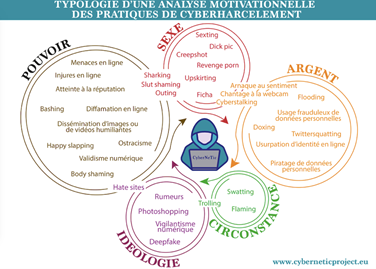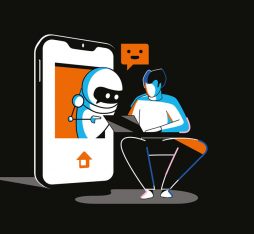- Digital
- Digital equality
- Home and Business Experiences
- Sustainable digital society
- Trust Security and Transactions
A persistent global phenomenon…
Cyberbullying is an attack on people, committed out using digital resources. This type of online behavior is constantly developing and expanding globally. A comparative study (with 25 countries taking part) carried out by Microsoft [1] in 2019 then in 2020, conducted among 12,520 adults, found, for example, that 64% of French respondents and 52% of respondents in the United Kingdom have already been victims of cyberbullying. Another American study [2] found that 41% of American respondents (out of a sample of 10,093 adults) have already been victims of cyberbullying, 28% of whom mentioned serious forms of bullying such as physical threats and sexual harassment.
International researchers currently face epistemological and methodological difficulties, and studies fail to offer a multidisciplinary understanding of cyberbullying, making it difficult to measure and making its prevalence difficult to assess. For example, frequently cited difficulties include access to data, geographically limited samples, or samples that are limited to a specifically targeted population such as minors.
The types and consequences of cyberbullying remain difficult to define. Cyberbullying leads to social exclusion from digital tools: categorizing specific practices means that everyone involved can prevent and effectively combat this social reality.
Cyberbullying is becoming a social reality and is difficult to manage, which makes effective coordination between public and private stakeholders difficult. In order to gain a better understanding of this phenomenon and to avoid unclear definitions, a research project [3] with Bordeaux Montaigne University and the French National Gendarmerie aims to collect and analyze specific data about online attacks or violence, in terms of cyberbullying, so as to specifically categorize the forms that it takes. How can this be achieved?
… With lack of a clear definition
The first step to take in order to delineate cyberbullying from a legal, social and technical perspective is to examine the way in which researchers have dealt with it, both in terms of the associated definitions and in the cases observed.
An initial search of articles using keywords yielded 14,267 articles, in international academic journals, accessible on portals such as Academic Research Ebsco, CAIRN, Open Edition and Scopus Elsevier. Several different terms were included, including online harassment, cyberbullying, cyber aggression, online aggression, and online violence. 311 articles, in French and in English, covering all continents were selected for peer review.
Based on this review of articles, there appears to be very few longitudinal studies. If they do exist, they are often linked to intergovernmental programs involving primary and secondary school students. Though most of the studies concern minors, and a few articles focus on professional groups such as journalists or influencers. It also appears that all disciplines (educational sciences, sociology, psychology etc.) are represented.
More specifically, many articles refer to online attacks directly aimed at the victim, both verbally, for example in the form of argumentative strategies (impoliteness, insults, threats on forums), or in the form of social attacks that may lead to the victim becoming excluded from online groups. Others discuss strategies to cause harm, such as creating a false profile for the victim, impersonating them, or hacking into their personal account.
It appears that, among victims, these forms of cyberbullying generate a change in the way they perceive the online environment, and specifically have a negative impact on their decision-making. Some victims reduce their online activities and connections while others remove them completely due to concerns about their professional reputation [4], suffering a loss of confidence in their effective management of social networks and traditional media [5]. Severe impacts on mental health are noted: this phenomenon produces lasting effects on victims offline, namely mental trauma, emotional stress, loss of motivation and research into retraining [6].
Based on this review of articles, there is a marked tension between the democratic rights that justify some types of misuse (freedom of expression, equal access to networks) and morality, what is legal and what is illegal. Though legislation is evolving, the laws that govern cyberbullying are still very recent, and the burden of proof makes complaints difficult and therefore rare [7].
In summary, cyberbullying, the forms and consequences of which are still difficult to define [8], leads to social exclusion from digital tools (platforms etc.) for victims, a deterioration in social networks and a decrease in the quality of self-expression in public spaces (self-censorship), and even loss of income, creativity and productivity.
A first response aiming to improve the classification of cyberbullying…
As part of the partnership between Orange, Bordeaux Montaigne University and the French National Gendarmerie, a multidisciplinary team harnessing skills in sociology, communication sciences and criminology aims to categorize existing cyberbullying practices and to put effective measures in place in order to help the victims and stakeholders involved to handle them. To this end, a survey was carried out in 2020 on a sample of 150 streamers and YouTubers, in addition to around 30 partially structured anonymized interviews with victims of cyberbullying, key witnesses (e-sports, web TV etc). In addition to these surveys, court records can also be used, which are a unique and exceptional source of analysis. In addition, exploratory interviews can be carried out with various stakeholder in the field of cyberbullying: psychologists, investigators in the Gendarmerie, lawyers, scientists, reception staff at facilities, cybersecurity experts etc.
Based on initial analyses, it appears that the multidimensionality of these behaviors can be roughly classified, as described on www.cyberneticproject.eu, and as shown in the below figure.

Figure: Classification of a motivational analysis of cyberbullying behaviors
This classification helps to facilitate the analysis of acts of cyberbullying, as discussed below, which shows that the main driving factor behind cyberbullying is gender. This is similar to sexting [9], an English neologism formed from the words “sex” and “texting” (sending text messages via SMS) which first started to appear in 2009, including in France.
The research work carried out led to the publication of a White Paper, which is due to be published in June. Having a glossary, i.e. a structured set of terms and data specific to cyberbullying, to rely on will help companies and the general public to better understand and manage complex situations relating to cyberbullying. Detailed information sheets will make it possible to accurately define cyberbullying practices, such as revenge porn, dating scams, identity theft, hateful comments etc. Given that these results stem from collaborative research work, all of these resources will be made available on the 3018 app [10], which was launched on February 8, 2022 by Orange.
This collaboration also involved building a prototype of a video game, developed in Visual Novel (graphic adventure-oriented gameplay, interactive fiction), which aims to create a realistic scenario of the victim, by offering immersive learning in order to encourage people to change their behaviors, therefore reducing exposure to online threats. This can now be downloaded from http://cyberneticproject.eu/index.php.
Conclusion
Providing a better definition of cyberbullying practices by taking advantage of the methods and concepts of social sciences helps to establish and, if necessary, deploy effective measures to fight cyberbullying. The publication of a White Paper and the design of a video game are the first specific outcomes of this unique partnership, which aims to shed light on the social conversation around cyberbullying and to promote new initiatives. With regard to the issues of mental health and social responsibility, other materials and analyses are being developed in order to help everyone involved to understand, recognize and diagnose cyberbullying practices, so as to rally both public and private stakeholders to address the issue.
Références :
[1] Microsoft Digital Civility Index (DCI) 2020: Study conducted by “Telecommunications Research Group for Microsoft Corporation”, Annual Report entitled “Civility, Security and Online Interaction”: https://news.microsoft.com/fr-fr/2021/02/09/safer-internet-day-le-civisme-en-ligne-sameliore-de-3-points-dans-le-monde/
[2] Pew Research Center, January 2021, “The State of Online Harassment”: www.pewresearch.org
[3] Project funded by the Digital Enterprise Research Area, led by Guillaume Tardiveau, Research Program Manager at Orange Innovation.
[4] Bossio, D., and A. E. Holton, 2019. “Burning out and Turning off: Journalists’ Disconnection Strategies on Social Media.” Journalism 20. doi:10.1177/1464884919872076.
[5] Chen, G. M., P. Pain, V. Y. Chen, M. Mekelburg, N. Springer, and F. Troger. 2020. “‘You Really Have to Have a Thick Skin’: A Cross-Cultural Perspective on How Online Harassment Influences Female Journalists.” Journalism 21 (7): 877–895.
[6] Ferrier, M., and N. Garud-Patkar, 2018. “TrollBusters: Fighting Online Harassment of Women Journalists.” In Mediating Misogyny, edited by J. Vickery and T. Everbach, 311–332. Cham: Palgrave Macmillan.
[7] In practice, the police or gendarmerie services have the capacity to file complaints by victims, to investigate cases or, at the discretion of the Public Prosecutor, to engage relevant specialized services: Research Department, Central Office for Combating Crime Related to Information and Communication Technologies (Office central de lutte contre la criminalité liée aux technologies de l’information et de la communication – OCLCTIC), Information Technology Fraud Investigation Brigade (Brigade d’enquêtes sur les fraudes aux technologies de l’information – BEFTI), Center for Combating Cybercrime (C3N), creation in February 2021 of the ‘French national center for addressing online hate’ known as the French national digital prosecutor’s office or digital prosecutor’s office. However, it is difficult to collect evidence even though proof is easily obtained by collecting records, taking screenshots, by experts. Etc. In fact, evidence can be unreliable and can be edited, making it easier to dispute, which can lead to procedural invalidities. The spokesperson from the Department of Justice followed up with some figures: “Between August 2014 and 2017, there were only 18 convictions for the offense of harassment committed via an online public communication service or a digital or electronic medium. There was only 1 conviction in 2014, 5 in 2015, 7 in 2016 (out of 235 reports filed) and 5 in 2017 (414 reports filed).” https://www.numerama.com/politique/533735-cyberharcelement-quatre-ans-apres-avoir-porte-plainte-des-victimes-attendent-toujours.html
[8] Joissans S., Bigot J., 2020, “Rapport d’information n° 613 (2019-2020), Cybercriminalité : un défi à relever aux niveaux national et européen” [Information Report No. 613 (2019-2020), Cybercrime: a challenge to be addressed at a national and European level], filed on July 9, 2020, URL: http://www.senat.fr/rap/r19-613/r19-613_mono.html#toc127
[9] Sexting, whether coercive or non-consensual, falls under Article 67 of the French Law for a Digital Republic of October 7, 2016 (known as the Lemaire Law). This sanctions the act of “bringing any recording or any document relating to words or images of a sexual nature, obtained with the express or presumed consent of the person or by the person, into the knowledge of the public, or of a third party in the absence of the person’s agreement to the dissemination”. If content is of a sexual nature, then this is an aggravating factor and the punishment for this offense ranges from one to two years in prison, and of a fine from €45,000 to €60,000.
[10]The 3018 application was developed with the support of Orange and the support of the Make.org Foundation, can be downloaded on all smartphones (iOS or Android), and is managed by the Association e-Enfance: https://www.service-public.fr/particuliers/actualites/A15501?lang=en












